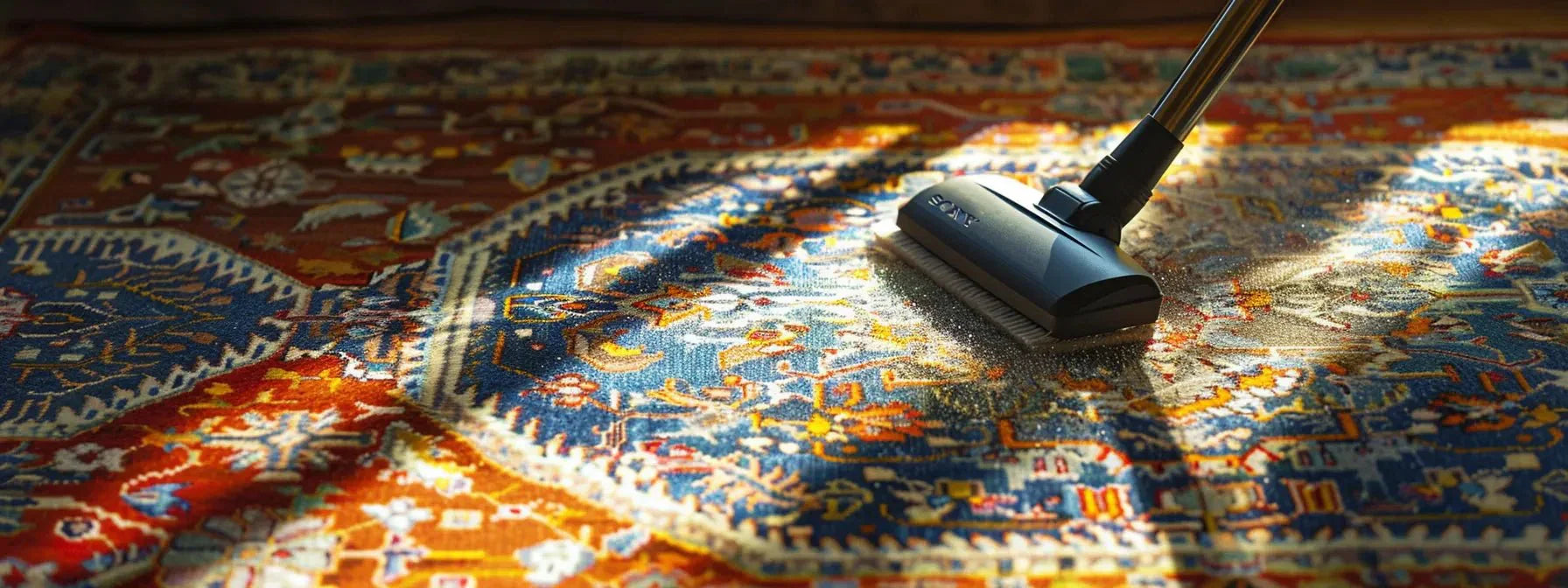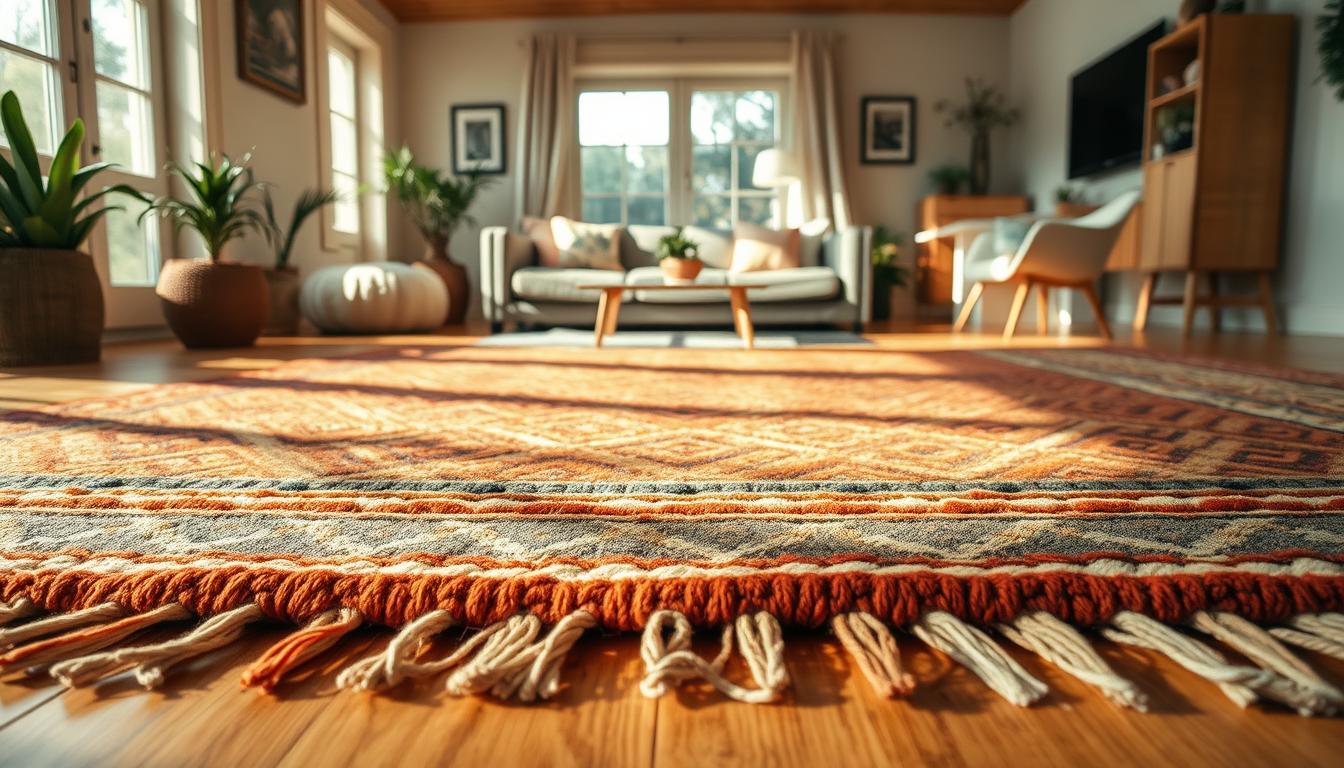
5 Things to Know About Woven Rugs
Have you ever wondered why some floor coverings last decades while others fray within years? The secret lies in craftsmanship—specifically, the meticulous interlacing of threads that transforms ordinary materials into heirloom-quality pieces. Unlike mass-produced alternatives, these textiles are built through a process perfected over centuries, blending artistry with structural integrity.

Each strand in these durable creations serves a purpose. Skilled artisans or precision machines weave warp and weft yarns into patterns that withstand heavy foot traffic. This method doesn’t just create beauty—it ensures softness underfoot and insulation that adapts to seasonal temperatures, making them practical for any room.
While the upfront cost might surprise some, consider this: a well-made piece becomes part of your home’s story. Designers favor them not just for visual impact, but for their ability to elevate spaces without sacrificing comfort. Their intricate designs range from geometric precision to free-flowing organic motifs, offering options for both modern and traditional décors.
Key Takeaways
- Superior durability comes from interlaced warp and weft construction
- Handcrafted versions are valued as functional art pieces
- Natural fibers enhance comfort and temperature regulation
- Higher initial cost reflects long-term value and craftsmanship
- Versatile designs complement diverse interior styles
Understanding Woven Rugs: Craftsmanship and Materials
The foundation of every exceptional floor covering lies in its construction. Materials and technique determine whether a textile becomes a fleeting trend or a lifelong companion. Skilled creators transform raw components into functional art through methods refined over generations.
Traditional vs. Machine-Woven Methods
Hand-crafted pieces involve meticulous labor. Artisans manipulate threads on a loom, tying each knot with purpose. This approach yields slight variations that signal human craftsmanship. One rug might take months to complete, embedding cultural stories into every inch.
Power looms revolutionized production. Computer-guided systems layer threads rapidly, ensuring pattern consistency. While lacking artisanal fingerprints, this method delivers affordability without sacrificing structural integrity. Both approaches use the same weaving process fundamentals but cater to different priorities.
Key Natural and Synthetic Fibers
Natural fibers dominate premium options. Wool stands out for resilience and insulation, thriving in high-traffic areas. Cotton offers breathability for casual spaces, while silk adds opulent sheen to formal settings.
Synthetics like nylon address modern needs. Stain resistance and vibrant color retention make these practical for homes with pets or kids. Blending materials creates hybrids that balance luxury with practicality.
What is Woven Rug: Definition and Distinct Features
Floor coverings with true staying power share one secret: their construction method. Vertical warp threads form the backbone, while horizontal weft strands interlock them tightly. This creates textiles where patterns become part of the fabric itself—not just surface decorations.
Intricate Weaving Process and Double-Sided Design
The weaving process locks colors and motifs between layers of threads. Unlike printed alternatives, these designs won’t peel or fade. Flip one over, and you’ll see an identical mirror image—a feature that doubles wear resistance. Rotate yours seasonally using proper maintenance techniques to maintain its like-new appearance.
| Feature | Benefit | Impact |
|---|---|---|
| Double-Sided Design | Even wear distribution | Lasts 2-3x longer than single-sided options |
| Integrated Patterns | Fade-resistant details | Retains vibrancy for 10+ years |
| Tight Warp/Weft Interlock | No edge fraying | Withstands 500+ lbs/square foot pressure |
Artistry and Durability in Every Thread
Skilled crafters transform threads into storytelling canvases. Geometric precision meets organic flow in patterns that elevate rooms from functional to extraordinary. These pieces withstand decades because their beauty isn’t skin-deep—it’s structural.
Natural fiber choices enhance resilience. Wool repels stains naturally, while cotton offers breathability. Even synthetic blends inherit the core strength of traditional weaving methods, proving practicality and elegance can coexist.
Comparing Woven and Non-Woven Rugs
Your flooring choice shapes daily life more than you might realize. Construction methods create distinct advantages and compromises that impact comfort, cost, and longevity.
Structural Differences in Construction
Non-woven versions bond fibers through heat or needle punching—like felt fabric. This creates lightweight, budget-friendly options perfect for temporary spaces. However, bonded threads loosen faster under pressure.
Interlocked warp and weft strands give woven textiles their signature strength. This method embeds patterns into the fabric itself, resisting unraveling even in entryways or hallways. As one textile expert notes: "The tighter the weave, the longer it withstands life’s foot traffic."
| Feature | Woven | Non-Woven |
|---|---|---|
| Construction | Interlocked threads | Bonded fibers |
| Durability | 10+ years | 2-5 years |
| Maintenance | Professional cleaning | Machine-washable |
| Best For | High-traffic areas | Low-use spaces |
Maintenance and Longevity Considerations
Spills? Non-woven types often survive washing machines—ideal for snack zones or playrooms. But repeated cleaning weakens their adhesive bonds over time.
Woven designs demand more care, especially natural fiber options. Vacuum weekly and blot spills immediately to preserve colors. The trade-off? Decades of service versus frequent replacements.
Your priorities decide: immediate savings versus lasting quality. Busy households often prefer durability, while renters might prioritize affordability.
Benefits and Drawbacks of Woven Rugs
Selecting floor decor involves balancing immediate appeal with lasting performance. Interlocked construction offers distinct advantages, but practical realities require thoughtful consideration.

Investing in Quality and Timeless Aesthetics
Wool rugs and other natural fiber options age like fine furniture. Their dense weaves endure years of foot traffic while maintaining vibrant patterns. Unlike printed designs, these textiles embed colors between layers, resisting fading even in sunlit rooms.
Artisanal craftsmanship elevates pieces beyond decor. Each thread contributes to textured depth that synthetic alternatives can’t replicate. As noted in a comprehensive comparison, this construction method creates heirloom-quality items that appreciate in character over time.
Practical Challenges in Care and Mobility
Premium materials demand attentive upkeep. Spills require immediate blotting to prevent staining, and professional cleaning becomes essential for preserving fibers. Rotating these pieces seasonally helps distribute wear evenly.
Their substantial weight complicates repositioning. Moving a 9x12-foot piece often requires two people—a factor renters should consider. While handmade wool rugs justify their higher budget allocation through longevity, initial costs may surprise those accustomed to disposable decor.
Design, Style, and Aesthetic Appeal
Your floor decor acts as a visual anchor, shaping how spaces feel and function. The right patterns can amplify light, define zones, or spark conversations. Let’s explore how centuries-old artistry meets today’s creative vision in textile design.
Timeless Motifs Meet Modern Flair
Traditional designs tell stories through symbols. Geometric medallions, floral vines, and tribal motifs reflect cultural legacies. These patterns thrive in formal dining rooms or libraries, adding gravitas to areas meant for connection.
Contemporary styles lean into abstract forms. Think asymmetrical shapes or gradient color blends that suit minimalist spaces. Designers now pair organic textures with metallic accents, creating pieces that feel both earthy and futuristic.
| Feature | Traditional | Contemporary | Impact |
|---|---|---|---|
| Pattern Complexity | Multi-layered motifs | Bold, simplified forms | Defines room character |
| Color Palette | Earthy tones | Unexpected contrasts | Sets mood intensity |
| Cultural Influence | Regional heritage | Global fusion | Adds narrative depth |
Looking for versatility? Wool options balance heritage designs with modern practicality. Their natural hues adapt to evolving trends, ensuring your decor stays relevant.
Current styles blend old and new. Imagine Persian-inspired patterns reimagined in muted pastels or Art Deco lines softened by hand-spun yarns. These hybrids honor craftsmanship while speaking to today’s aesthetic sensibilities.
Choosing the Right Rug for Your Home
Selecting floor textiles requires more than color preference—it demands strategy. Three pillars guide smart decisions: lifestyle alignment, financial planning, and visual harmony. Let’s explore how to balance these elements for spaces that reflect both taste and practicality.

Budget, Functionality, and Maintenance Tips
Start by mapping your room’s foot traffic. High-use areas like entryways need tightly woven pieces with dense warp threads. For low-traffic zones, consider lighter options that prioritize style over heavy-duty construction.
Create a budget accounting for long-term value. While premium choices cost more upfront, their 10+ year lifespan often beats replacing cheaper alternatives every 2-3 years. As one designer advises: "Invest where feet tread most—save elsewhere."
| Factor | Priority | Solution |
|---|---|---|
| Pet-Friendly | High | Stain-resistant synthetics |
| Allergy Concerns | Medium | Hypoallergenic cotton blends |
| Rental Space | Low | Machine-washable options |
How to Match Textiles with Your Decor
Scale matters most. Allow 18-24 inches of bare floor between your piece’s edges and walls. In dining areas, ensure chairs stay fully on the textile when pulled out—this prevents tripping and visual imbalance.
Color schemes thrive on contrast. Pair neutral furniture with bold geometric patterns, or let vibrant upholstery shine against earthy tones. For open-concept spaces, use matching pieces to define zones without visual clutter.
Check the back of any potential purchase. Tight, even stitching indicates quality craftsmanship. Frayed edges or loose threads signal shortcuts—red flags for durability.
Conclusion
Choosing floor decor requires balancing practicality with personal taste. For spaces needing resilience and heritage charm, pieces crafted through the weaving process shine. Their interlaced materials—whether wool, cotton, or silk blends—offer lasting performance that cheaper alternatives can’t match.
Your lifestyle dictates the ideal choice. High-traffic areas benefit from dense patterns locked between warp and weft threads. Prefer low-maintenance options? Explore bonded alternatives, but know they’ll need replacing sooner. As highlighted in this comprehensive comparison, both types enhance rooms when matched to your needs.
Invest in pieces that grow with your home’s story. Skilled artisans imbue each creation with character, transforming functional items into legacy accents. Whether your style leans modern or traditional, the right selection elevates daily living while honoring timeless craftsmanship.
FAQ
How do hand-woven rugs differ from machine-made options?
Hand-woven rugs involve artisans using looms to interlace threads manually, creating unique designs with natural fibers like wool or silk. Machine-made versions use synthetic materials like nylon for faster production, often sacrificing individuality for affordability.
Which materials are best for high-traffic areas?
Wool is a top choice for durability and stain resistance, ideal for busy spaces. Synthetic fibers like nylon offer budget-friendly alternatives, while silk adds luxury to low-traffic rooms. Consider your lifestyle and room usage when selecting.
Why are woven rugs considered double-sided?
The tight weaving process on a loom creates reversible designs without a backing layer. This feature enhances versatility, allowing you to flip them to reduce wear patterns or refresh your decor style effortlessly.
How do flatweave rugs compare to tufted or knotted styles?
Flatweaves lack a plush pile, making them lightweight and easy to clean. Tufted or hand-knotted rugs have thicker textures but require more maintenance. Choose based on your preference for comfort versus practicality.
Are woven rugs suitable for homes with pets or spills?
Tightly woven wool rugs resist stains and hide dirt well, but avoid delicate materials like silk in spill-prone areas. Regular vacuuming and prompt cleaning help maintain their quality over time.
Can I find modern designs in woven rug collections?
Yes! While traditional patterns like Persian motifs remain popular, contemporary trends feature geometric shapes, abstract art, and minimalist styles. Brands like Safavieh and Jaipur Living blend timeless craftsmanship with current aesthetics.
What factors should I prioritize when selecting a rug?
Balance budget, room function, and decor harmony. For example, choose durable wool for entryways and soft blends like wool-silk for bedrooms. Measure your space to ensure the rug complements furniture layouts and lighting.









